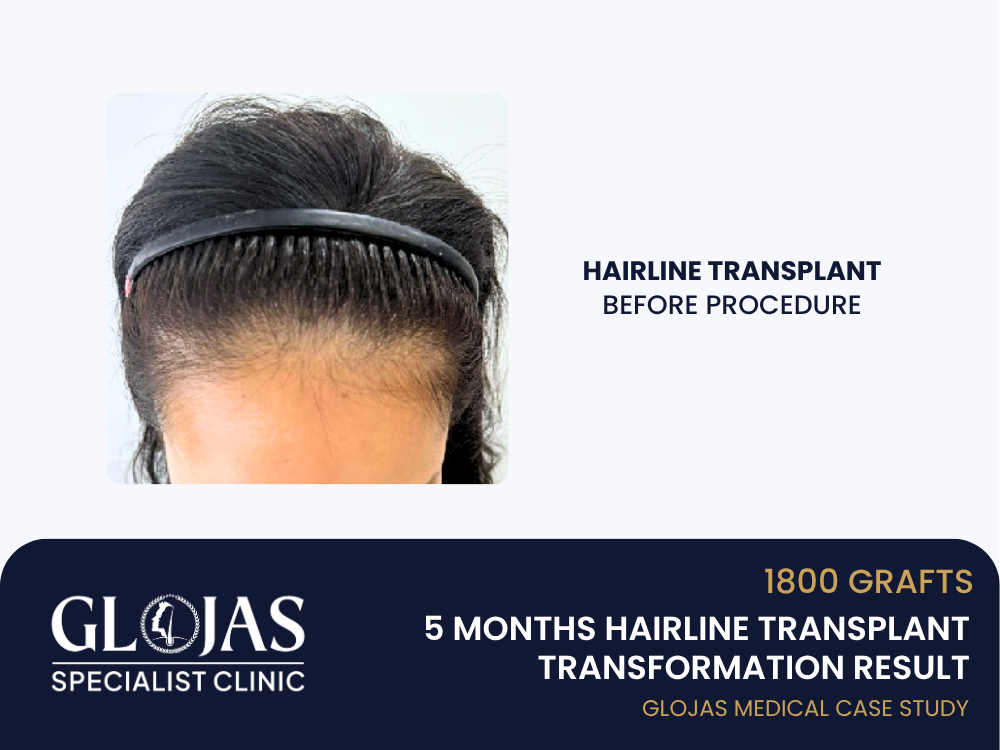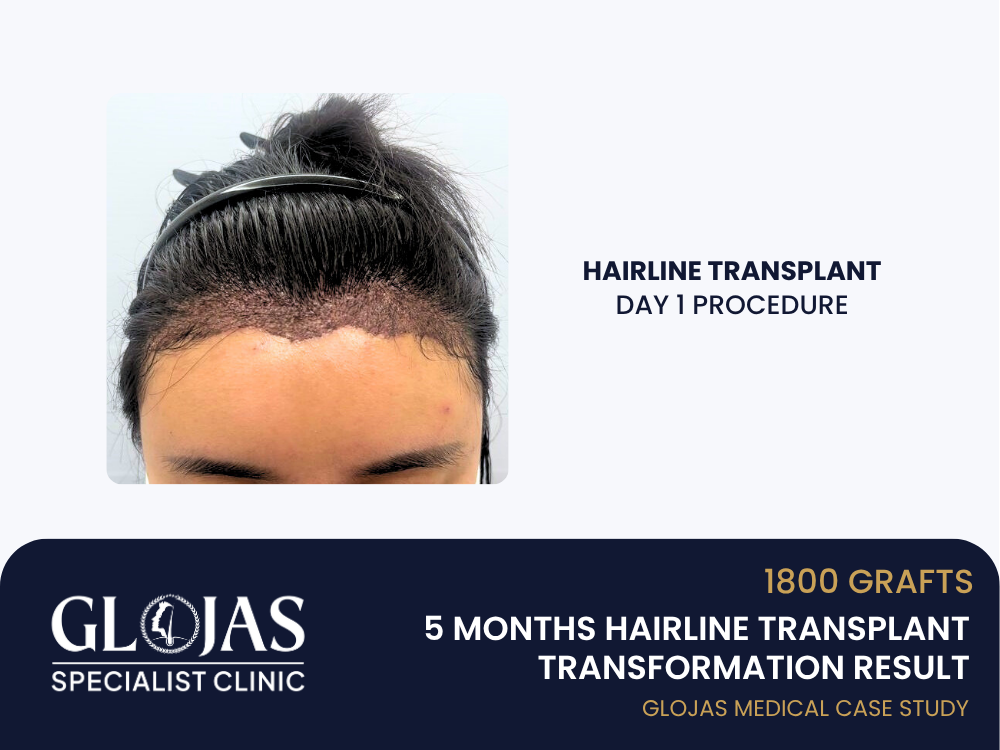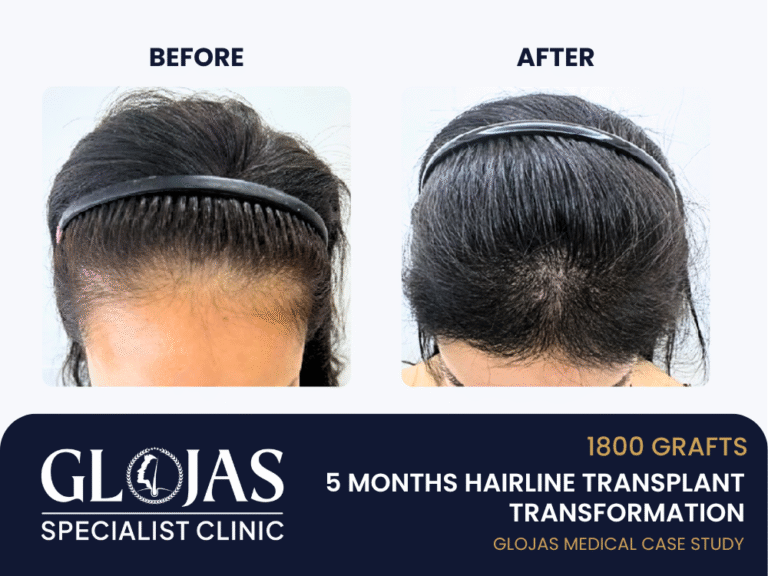A high or wide forehead can affect facial proportions and lead to self-consciousness, especially in women. Many individuals seek ways to balance their facial aesthetics, and one of the most effective solutions is hairline lowering via hair transplant.
This case study follows a 30-year-old female patient who underwent a SMART™ FUE Hairline Lowering Transplant using 1,800 grafts. In just 5 months, she experienced a dramatic yet natural improvement in her facial appearance.
Patient Profile
Age: 30
Gender: Female
Concern: Naturally wide forehead; high hairline since teenage years
Previous Attempts: Bangs/fringes to hide forehead; no prior surgical/cosmetic procedures
Hair Type: Straight, thick, black
Skin Type: Fitzpatrick IV
Goal: Achieve a more proportionate and feminine hairline with a lower natural curve
Consultation & Design – Hairline Lowering
During her consultation, a full facial analysis was performed. The goal was to create a softer, rounder hairline that would complement her natural features and reduce the vertical height of her forehead by 2–2.5 cm.
Key considerations:
Natural density and angling of hair
Avoiding unnatural straight lines
Preservation of future styling options (e.g., tying hair up)
Decision: Lower hairline by 2.3 cm using 1,800 grafts
Procedure Overview

Technique Used: SMART™ FUE
Grafts Transplanted: 1,800
Duration: ~6 hours
Anesthesia: Local
Donor Area: Occipital scalp
Recovery Time: 7–10 days
Graft Placement:
Frontal Hairline Zone: 1000 grafts
Temporal Zones (sides): 800 grafts for natural frame and blending
Why SMART™ FUE?
SMART™ FUE is an advanced, minimally invasive hair transplant malaysia method designed for high-precision follicle extraction and placement. It’s especially ideal for delicate aesthetic areas like the female frontal hairline, where direction, angle, and density are critical.
Benefits include:
No linear scar
Natural curvature and direction
Faster healing with minimal downtime
High graft survival rate
Recovery & Growth Timeline

| Timeline | Progress |
|---|---|
| Week 1 | Mild redness and scabbing in the transplanted area |
| Week 3–4 | Shock loss (temporary shedding of transplanted hair) |
| Month 2 | Early new hair growth, thin and soft baby hairs |
| Month 4 | Noticeable increase in density; new hairlines take shape |
| Month 5 | 70–80% visible result; natural-looking lowered hairline achieved |
Before & After (5-Month Result)

| Before | After 5 Months |
|---|---|
| High hairline with broad upper forehead | Reduced forehead height with smooth, rounded hairline |
| Reliance on bangs to cover the forehead | Comfortable wearing hair back confidently |
| Uneven facial proportions | Improved harmony and softer, more feminine features |
Patient Feedback
“I always hated how high my forehead looked. It made me insecure and I would never go out without bangs. After the transplant, my whole face looks more balanced. I can tie my hair up now without feeling self-conscious — it’s honestly life-changing.”
Aftercare Routine
Sleep elevated for 3 nights post-procedure
No direct sun exposure for 2 weeks
Avoid sweating, tight headbands, or hats initially
Mild shampoo after Day 3
No hairstyling products or heat tools for the first month
Optional: PRP booster session at Month 3 (patient opted in)
5 Frequently Asked Questions (FAQ)
1. How is a female hairline lowering different from a typical hair transplant?
Female hairline lowering focuses on aesthetics — it requires softer curves, dense packing, and smaller grafts for a natural look. The procedure is designed more for framing the face than covering baldness.
2. Can the hairline be shaped as per personal preference?
Yes, to an extent. The surgeon designs a natural-looking hairline based on the patient’s facial structure, symmetry, and anticipated future aging. While input is welcome, the final design should provide aesthetic proportions and long-term results.
3. Are the results permanent?
Yes. The transplanted hairs are taken from the back of the scalp (DHT-resistant) and are permanently rooted in the new location. They grow and behave like natural hair.
4. When can I resume normal activities?
Most patients return to light activity in 3–5 days. Full scalp healing takes 7–10 days. Hair styling, coloring, and heat treatments can resume after 4 to 6 weeks.
5. How natural will the result look?
With SMART™ FUE, the result is indistinguishable from natural hair. The density, angle, and curl pattern are matched during graft placement to blend perfectly.
✅ Conclusion
This case proves how SMART™ FUE Hairline Lowering using 1,800 grafts can significantly improve facial harmony for women with naturally wide foreheads. In just 5 months, the patient achieved a softer, well-framed appearance that elevated her confidence and styling freedom.
For women seeking a subtle, elegant transformation without scarring or downtime, SMART™ FUE hairline lowering offers one of the most effective solutions available today.
